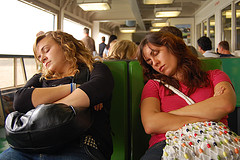Top 6 Tips for Avoiding Jet Lag on Long Distance Trips
4 April 2012
Most travelers want to make the most of their time when they arrive after a long distance trip, and avoiding jet lag is crucial to ensuring that happens. Unfortunately, it can take a person several days to catch up after leaping across many time zones in a matter of hours.
Until you do catch up, know the symptoms of jet lag. You may experience severe sleepiness during daylight hours, insomnia at night, problems concentrating, general confusion (making you a target for thieves and con artists), and more.
Here are our top tips for avoiding jet lag on long distance trips.
1. BYOB – your own water bottle, that is
Staying hydrated is the first and most important step for avoiding jet lag. The air inside an aircraft hovers around 15% – compare that to the world’s dries place, the Atacama Desert, where humidity levels are around 16%.
The fix: carry your own water bottle. Once you pass through security, fill it at a food vendor or from a water fountain. If you can drink it all before take-off, even better because you can fill it again with fresh water. After all, you can’t be guaranteed bottled water on the plane and the flight attendants may refill empty water bottles with the water carried in the airplane’s holding tanks (a known bacterial breeding ground).
Bonus: drinking all that water is sure to get you up and moving about the plane – a sure way to fight DVT, the real danger of flying.
2. Stay away from caffeine and alcohol
Caffeine and alcohol disrupt sleep patterns and cause dehydration. Both on the flight and for as much of the day before and after your flight, avoiding caffeine and alcohol will help you stay hydrated and avoid sleep disruptions when you do sleep.
The fix: see # 1 above
3. Take good care of your skin, lips, and eyes
That dry air is also a problem for your skin and eyes, which can make you itchy and uncomfortable. Itchy, dry skin and cracked lips can also make you look a lot worse than your passport photo.
The fix: if you wear contacts, carry eye drops and use them regularly during the flight. If possible, consider removing your contacts entirely (you can put them back in just before or after landing). Carry light moisturizers and lip balm and use them during the flight. Non-scented options are likely to keep your seatmates happier.
4. Eat light and healthy – before and during your flight
Most travelers don’t eat the food they’re offered on the plane because they’re hungry and it’s certainly not because they like it – they do it because they’re bored. The forced immobility and pressurization can have odd effects on your system, however, and eating light and healthy snacks can keep you feel more energized, especially if the foods you are eating are packed with fluids (think apples and celery).
The fix: most airports now have vendors who carry healthy and portable options. Carry high fiber snacks such as fruit and nut mixes in your carry-on and you’ll be able to fight post-flight constipation and keep your energy levels high.
5. Wear light, loose layers
We all know that airplane seating is snug and the temperatures can fluctuate drastically. If you’re too hot or too cold, or if your clothing is restricting, you’ll be uncomfortable.
The fix: Wearing loose, comfortable is essential and layering helps you remove or add clothing as the temperatures change.
6. Sleep as best you can
Here’s where things get tricky. Many people swear by a variety of supplements to help them fall asleep during the flight, but others have difficulty with them and a long flight is not the first place to give a sleeping pill a try. After all, you don’t want to navigate customs, car rentals, etc., if you’re half asleep. In fact, many experts recommend that travelers avoid them entirely because the resulting inactivity can contribute to the formation of blood clots, a very dangerous condition.
The fix: all of the above fixes will help you feel more comfortable and encourage sleep. Many travelers find eye masks and ear plugs or noise-reducing headphones useful too. If you feel like sleeping, then sleep because you’ll need to stay awake until dark when you arrive, but find a method to wake yourself up a few times during the flight to walk around and stretch.
After Arrival
After you arrive, get outside and walk – this will help your body reset its natural time clock with the sun and it will help your circulation (which has taken a hit by being still on the plane). Most experts recommend finding a way to stay up until well past dark in your new time zone as the key for sleeping through the night and waking with energy. It’s also noted that this can take a couple of days.
Be realistic. If you feel a little ‘off’ the first couple of days after arriving, recognize it for what it is – a little jet lag and keep drinking clean fresh water, eating healthy, and getting light exercise outside (preferably in the sunshine if you can manage it). You should feel much better in a day or two.
Damian Tysdal is the founder of CoverTrip, and is a licensed agent for travel insurance (MA 1883287). He believes travel insurance should be easier to understand, and started the first travel insurance blog in 2006.

